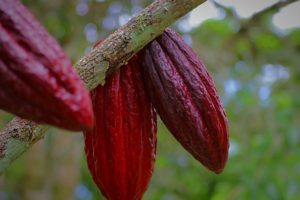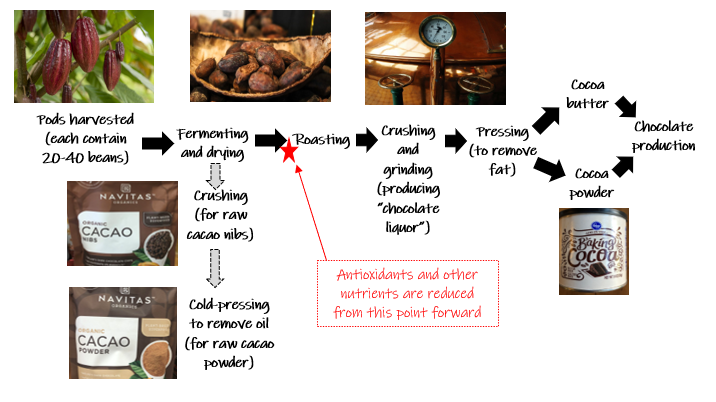 Are cocoa and cacao the same thing?
Are cocoa and cacao the same thing?
And should you believe those headlines about losing weight by eating chocolate?
So, what’s the deal? We want to help you sort through the confusion.
First, let’s start by saying not all chocolate is created equal!
There are many differences in taste and nutrition of cacao and cocoa and all the different chocolate products, and it really all comes down to the amount of processing and the ingredients added during the production process.
There is one thing that all chocolate has in common…it comes from cacao beans.
 These beans grow in pods that are found on Theobroma cacao trees. These cacao pods are actually the size of a football and each pod contains up to 40 or 50 cacao beans. Because the pods will not fall from the tree, they must be harvested by hand…an extremely manual process!
These beans grow in pods that are found on Theobroma cacao trees. These cacao pods are actually the size of a football and each pod contains up to 40 or 50 cacao beans. Because the pods will not fall from the tree, they must be harvested by hand…an extremely manual process!
The good news: cacao beans are a nutrient powerhouse!
They are loaded with antioxidants, even more than antioxidant-rich foods like red wine, green tea and blueberries. They are also full of iron, magnesium and other nutrients.
Cacao provides many health benefits including:
- improved blood pressure (by helping oxygen flowing through your arteries)
- lower LDL (bad cholesterol) and higher HDL (good cholesterol)
- helps prevent heart disease by protecting against hardening of the arteries
- helps regulate insulin levels
- has even been shown to significantly improve your mood!
Once cacao beans are harvested, they are fermented and dried. This starts to give them their chocolate flavor and aroma. The future for these fermented and dried beans can now go a couple of different directions.
Nutritious Cacao Nibs and Cacao Powder!
A very small percentage of the beans are crushed and turned into raw cacao nibs and cacao powder. Cacao nibs are finely chopped pieces of the fermented and dried cacao beans:
- They retain the beneficial nutrients!
- They are more bitter than the chocolate chips most people are used to.
- They do not melt the same as other chocolate chips, but provide a great crunch and a subtle chocolate flavor.
Some of these cacao nibs are turned into cacao powder…the nibs are cold-pressed to extract the oil (cacao butter), and then what remains is dried into a powder.
 We have fallen in LOVE with cacao nibs!
We have fallen in LOVE with cacao nibs!
Especially as our taste buds have changed during our REAL food journey, we now really enjoy these cacao nibs in a variety of ways including in the Pumpkin Tiramisu Overnight Oats, Mocha Chocolate Chip Muffins, homemade trail mix, and the Peanut Butter Power Balls. For the cacao powder, you could use it in meals like the Cincinnati-Style Chili and the Sausage & Black Bean Mole Enchiladas.
Now for the not-as-good news… as the cacao beans are processed, we start to lose out on those beneficial nutrients.
So, what happens to the “other beans?”
 For the vast majority of the cacao beans – that aren’t turned into raw cacao nibs or powder – they are roasted, which deepens their chocolate flavor and adds some sweetness. Then, after being roasted, they are crushed and ground, producing a non-alcoholic “chocolate liquor.” This liquor is then pressed to remove the fat (which is called “cocoa butter”), and then what is left can be processed into cocoa powder.
For the vast majority of the cacao beans – that aren’t turned into raw cacao nibs or powder – they are roasted, which deepens their chocolate flavor and adds some sweetness. Then, after being roasted, they are crushed and ground, producing a non-alcoholic “chocolate liquor.” This liquor is then pressed to remove the fat (which is called “cocoa butter”), and then what is left can be processed into cocoa powder.
So, now you can see that cacao powder and cocoa powder (baking cocoa) really are different.
Unfortunately, the roasting and other processing does affect the nutrient content. It’s all about trade-offs… cocoa powder has fewer nutrients and less antioxidant power, but it does have a sweeter taste. And, although cocoa powder isn’t the same nutrient powerhouse as raw cacao powder, is still a good choice (just make sure it is 100% cocoa).
Is that all? Well, not quite.
There is one more thing to keep in mind…
 Look for dark chocolate that has NOT been “processed with alkali” or “Dutch processed.” When cocoa is processed with alkali (or “Dutch processed”), it has been processed in a chemical solution to enhance its color, reduce its bitterness and give it a smoother texture. Unfortunately, this also dramatically reduces the nutritional content of the chocolate (by as much as 90%).
Look for dark chocolate that has NOT been “processed with alkali” or “Dutch processed.” When cocoa is processed with alkali (or “Dutch processed”), it has been processed in a chemical solution to enhance its color, reduce its bitterness and give it a smoother texture. Unfortunately, this also dramatically reduces the nutritional content of the chocolate (by as much as 90%).
We are sorry to be the bearer of bad news…you may be shocked to know Dove chocolate and Hershey’s Special Dark ARE both processed with alkali, and are NOT the healthy choice you may think they are! Better choices include the 60% or higher dark chocolate made by Endangered Species, Alter Eco, Green & Black’s, Ghirardelli, Lindt and Moser Roth (found at Aldi stores). But still read those ingredients because, for example, Moser Roth 70% bars are NOT processed with alkali, but 85% bars are…go figure!
The bottom line:
- Experiment with raw cacao nibs and raw cacao powder and see what you think! They can be slightly more expensive but we have found some great deals at stores like TJ Maxx.
- Look for cocoa and chocolate that has NOT been “processed with alkali” or “Dutch processed.”
- Buy dark chocolate with a cacao content of 60% or higher (the higher, the better!).
- As always, read those ingredient labels!
Do you have a tip or experience when it comes to cacao, cocoa or chocolate? Please share!
 LEARN MORE ABOUT THE NAPKIN!
LEARN MORE ABOUT THE NAPKIN!



If the ingredient label does not say “Dutch processed” or “alkali”, can we presume it has not? If the ingredient label simply says “chocolate liquor” can we presume no on the Dutch or alkali process as well?
Looks like I got fooled-purchased cocoa nibs rather than cacoa nibs so I guess not the nutrient power house I was hoping for?😕
Thanks much for the information!
Great question! If the cacao, cocoa or chocolate has been processed with alkali, this should be listed in the ingredients. If your cocoa nibs haven’t been processed with alkali, they will still contain some beneficial antioxidants and nutrients…just not to the same level as raw cacao nibs. The food companies certainly don’t make it easy, do they?!
Very educational! I purchased a canister of Hershey’s Cocoa that stated “100% CACAO” on the front of the canister. However, on the side panel, the ingredient states “COCOA”. So, did I purchase CACAO or COCOA?
This is another example of the food companies creating unnecessary confusion! Unfortunately, “cacao” and “cocoa” are often used interchangeably. One way to think about it is “cacao” refers to the beans in their natural form. Once the beans start undergoing more processing (roasting and subsequent steps), they start to lose some of their antioxidants and nutrients. Because the term “cacao” has a health halo associated with it, some companies will use “cacao” on their food labels even though a lot of processing has taken place. While it is possible to find raw cacao powder, that is not what the Hershey’s product is. While the product started as cacao beans, it has been processed into the “cocoa powder” you see in our graphic above.
We do celebrate you looking at the ingredients! You did find the one that is just “cocoa.” They make another version the call “Special Dark” and I think it also says 100% cacao. Sounds like a great choice, right? But when you look at the ingredients, you will see it is “processed with alkali.”
So, if you don’t buy the raw cacao powder (which is more expensive), any variety where the only ingredient is “cocoa” is a perfectly good choice. It would be nice if the food companies didn’t make it so confusing!